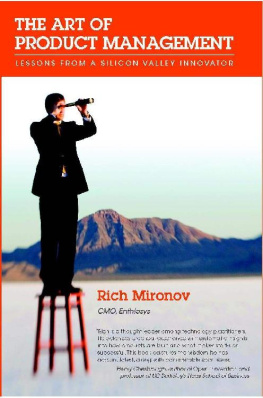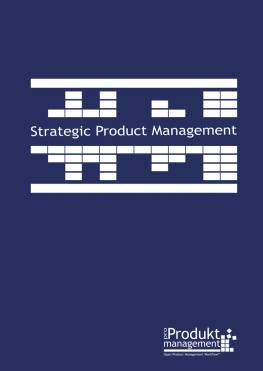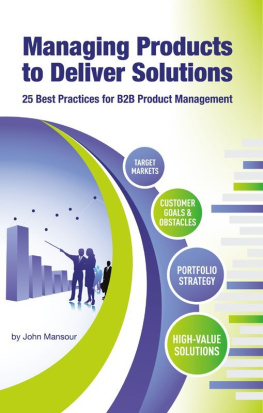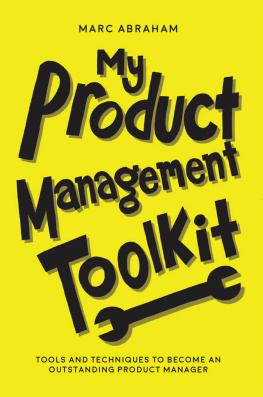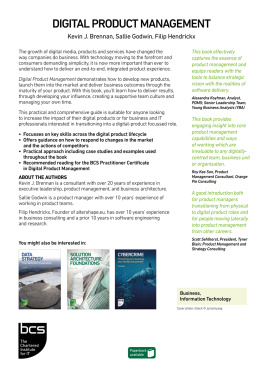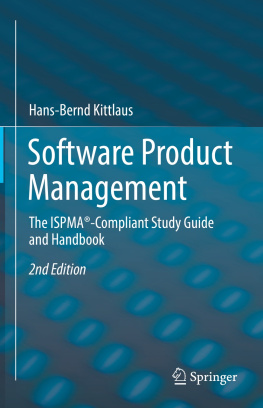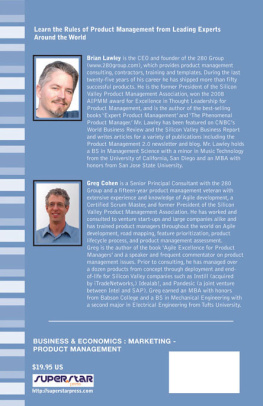
The Art of Product Management
Lessons from a Silicon Valley Innovator
Rich Mironov
Enthiosys Press
Mountain View, California
All contents Rich Mironov, 2002-2009.
All rights reserved, no part of this publication may be copied, reproduced, or stored by any means, electronic, mechanical, optical, or otherwise without the prior consent of the author.
ISBN 1-4392-1606-1
To Marcia, source of all good things, and Sasha, my Chief Analogy Officer
Table of Contents
Introduction
Henry Chesbrough
Adjunct Professor and Executive Director, Center for Open Innovation, Haas School of Business, UC Berkeley
There are lots of books (some of them quite good) on the importance of innovation for business success. I myself have written a few. Indeed, its hard to find anyone who has a bad word to say about innovation these days. As we head into choppy economic waters, though, it is not enough to know that innovation is important. We also need to understand what specifically needs to be done, and how best to get that done.
One area where innovation gets down to business, is in the arena of product management. This amorphous term is the label applied to some of the most important work that goes on in the innovation process when developing and introducing a new product (or, for that matter, managing an existing product). The product management function is responsible for uncovering and articulating the markets need for a new product or service. At the same time, product managers work closely with engineering to discern the technical possibilities and challenges facing the new product. The product manager must dance between the technical organization inside, and the world of the customer outside. Done poorly, product management can waste time and money, and deliver a product that few people wish to buy. Done well, product management leads to products that people want, that work well in their intended use, and become profitable businesses for the company.
This is where my friend and colleague of long standing, Rich Mironov, comes in. Like me, he agrees that innovation is important. Like me, he has been there, working in the trenches in a variety of product management functions across a range of Silicon Valley companies. His career spans nearly a quarter century (I barely lasted a decade before moving into academia). Richs experience and success have made him a thought leader among technology practitioners. While he has extensive experience, he also possesses a unique ability to reflect upon that experience to uncover more systematic insights into the sources of success and failure in developing products and launching startup companies. And while he is highly skilled in understanding technology, his deepest insights relate to the human heart - and how people (and their motivations) affect technology products and vice versa. I currently teach at the Haas School of Business at UC Berkeley, and Rich has been a frequent guest lecturer in both the MBA and the executive education classrooms there.
When you read this book, youll see the wisdom he has accumulated along with his considerable scar tissue. I promise you that there is nothing else out there quite like it.
I remember reading the first installment of what was then called Product Bytes, back in 2002. I became an immediate and enthusiastic fan. These pieces are short, to the point, with a light touch, that nonetheless lead to very important and actionable insights. Most of these insights were learned the hard way by Rich. But throughout this book, youll see that he never becomes cynical or disillusioned. Like me, he believes in his heart that we must innovate to continue to advance, though there will be plenty of roadblocks and snafus along the way. With this book, Rich shares with you some of the lessons he has learned. Anyone wrestling with developing new products, or launching a new startup company, will find this an invaluable resource to return to again and again. I predict youll laugh, perhaps cry, and emerge a little wiser each time you read from this book.
Foreword
DAVID STROM
There are a lot of computer-related books on the market. But there are very few of them that actually teach you how to market software and hardware products and not repeat the mistakes of the past.
Ive known Rich through several jobs over the past ten years, and now can be outted as his unofficial writing coach. I told him before he started his monthly newsletter, Product Bytes, that he needed to make sure that this was something he wanted to do. I suggested he write the first three issues, and if he still had something to say, then he was probably going to succeed at the effort. Ten years later, he is still going strong.
Good writing is often overlooked by product people, even though it can help you define your ultimate customer base, understand your products feature set, and explain why you need certain resources to tell your story and differentiate your products. Maybe I am more sensitive to bad writing than others after all, I didnt start out my career as a writer. Au contraire, I was a math and engineering major in college and it wasnt until my mid-20s that I learned how to write. It was a hard-acquired skill, and one that requires daily practice if you are going to be good, let alone great, at it. I am lucky that I am able to make a living at my writing, and that there are still plenty of interesting products to test and write about after being in the IT industry for more than 25 years.
Anyway, enough about me. This book is well worth your time. It is chock full of practical advice, and should be a bible for computer product managers, even those that are already parents of small children and think they are good at that unpaid job.
Part of Richs message is that the product is really secondary to the people who work at the company. One of the reasons why Dilbert still continues to resonate with high-tech workers is that there are so many bad managers, or managers who dont understand how to mentor and develop their staff.
The whirl of Web 2.0 and social networks have made this problem worse, rather than better. LinkedIn and Facebook have made it easier to move to another job and stay in touch with your former colleagues I just heard from someone that I worked with 25 years and countless number of job changes ago. Email has become second nature. It is easier to surround ourselves with screens rather than get out of our cubicles and have some face time with a co-worker.
If we have learned anything from the dot-bomb bust years at the beginning of this decade, it is that companies need to pay more attention to the marketing of their products. We are no longer in an era of build-it-and-they-will-download. Take some time to review Richs precepts, and see if you can do a better job of parenting your products.
David is an international authority on network and Internet technologies. He has written extensively on the topic for 20 years for a wide variety of print publications and websites, such as The New York Times, TechTarget.com, PC Week/eWeek, Internet.com, Network World, Infoworld, Computerworld, Small Business Computing, Communications Week, Windows Sources, c|net and news.com, Web Review, Toms Hardware, EETimes, and many others. He is the author of two books: Internet Messaging (Prentice Hall, 1998) which he co-authored with Marshall T. Rose and Home Networking Survival Guide (McGrawHill/Osborne, 2001).
Preface
RICH MIRONOV
Im a repeat offender at technology start-ups. That includes being the product guy at four very early stage companies, and consulting to product and technical teams at more than two dozen other companies.
Next page
